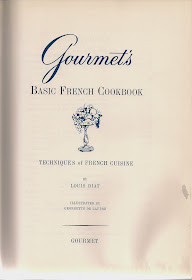The book: The Arabian Delights Cookbook by Anne Marie Weiss-Armush, published in 1995.
 |
| ISBN 1-56565-219-3 |
Ms. Weiss-Armush's fresh perspective on an ancient culture brings insight to us all.
She tells us that hummos, a silky protein-rich dip, is part of the mezzah: "the fascinating array of small appetizers displayed on a multitude of miniature oval trays ... incredible in number and exciting in variety."
Mezzah means "half" and is supposed to suggest "half a dinner" but she is honest in pointing out that she rarely progresses past this phase. "It is impossible to stop nibbling these wonderful specialties, and the appetite may be satiated rather than stimulated." She lists savory pastries filled with cheese or meat, fresh or pickled vegetables, olives, bean salads, stuffed grape leaves, torn pieces of pita bread, and of course, dips like hummos.
One thing I noticed about her recipes for the mezzah is that many have just a few ingredients and a few simple steps for preparation. This makes sense if you are the cook and need to prepare a variety for the afternoon meal.
I love hummos (in my area, spelled "hummus") but have always purchased it. It just seemed right to learn how to make it so I can play with the flavors and have it handy for impromptu meals.
Hummos (page 33)
1 3/4 cups cooked chickpeas (garbanzo beans)
1/4 cup low-fat yogurt, water, or liquid in which the chickpeas were cooked
2 cloves garlic, crushed with salt
1/4 cup tahini (ground sesame seeds)
1/3 cup lemon juice
Garnish: olive oil, paprika, cumin, black Middle Eastern olives, minced parsley
1. Puree the ingredients in a blender or food processor, reserving a few whole chickpeas for garnish.
2. Add additional tahini and/or lemon juice if necessary until you have achieved a flavor and consistency that suits your taste. This texture should be thinner than mashed potatoes but with enough body to hold an edge.
3. Spread in an earthenware dish or an oval serving platter, running the side of a spoon around the edge to create a slight rim. Drizzle with olive oil and garnish with the reserved chickpeas, paprika, cumin, and olives to add a bit of color. Serve with Arabic bread.
 |
| Easy peasy! |
Success! This couldn't be any easier. Put the ingredients in the blender--I put the liquids in first to help get the garbanzo beans started--and blend until the whole mixture is smooth, creamy, and uniform in color.
The recipe as she gave it suited my tastebuds just fine. I felt no need to add anything more.
I've never cooked with tahini before. It is like a very liquid peanut butter and added a depth of flavor and a slight bitterness that was pleasant. The lemon juice adds a sparkle and lightness to the overall flavor.
It was fun to sprinkle on the garnishes to make it look pretty. I think if I was serving it to a crowd, I would have put the hummos in a shallow and wide dish, so everyone could get to it easily.
A dash across the 'net reveals that records of hummos go back as far as the 700s A.D. The ingredients themselves are ancient but the idea of blending them into a dip is not lost to history.
This was so simple that I want to explore variations on the theme. I've had a store-bought hummus that was made with white beans and had minced basil mixed in. I swear to you it tasted like luscious, creamy pesto and I felt sinful eating it on crackers. Not that I stopped, mind you.
April, 2014 Update: One 15 ounce can of garbanzo beans held just the right amount for this recipe. The kind I bought was just beans, water, and salt, so I used the liquid from the can as the required liquid and adjusted the amount of salt with the garlic.







